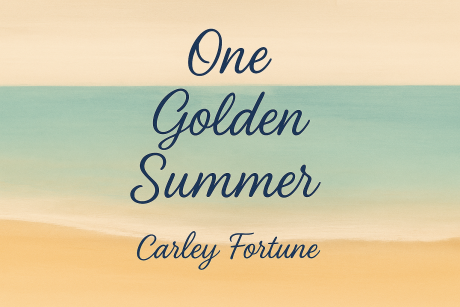One Golden Summer by Carley Fortune
BOOKS REVIEW
Chaifry
7/13/20258 min read


One Golden Summer (2025), the fourth novel by Canadian author Carley Fortune, published by Berkley, is a radiant romance set in the lakeside town of Barry’s Bay, Ontario, first introduced in her debut novel. A former journalist, Fortune crafts a contemporary love story that blends nostalgia, personal growth, and heartfelt connection. The novel centers on Alice Chen, a photographer, and Charlie Florek, a charismatic handyperson, whose summer sparks love and self-discovery. This review argues that One Golden Summer is a must-read for its evocative portrayal of healing, love, and rediscovery, offering Indian readers a universal narrative of resilience and connection that resonates with their cultural and personal journeys in a rapidly modernizing society.
One Golden Summer unfolds in Barry’s Bay, where Alice Chen, a burnt-out commercial photographer, seeks solace after a stagnant career and personal life: “I’ve been dreaming of spending a quiet summer on the water” (Fortune, 2025, p. 3). At seventeen, Alice spent a transformative summer there with her grandmother, Nan, capturing a photograph of three teenagers in a yellow speedboat—Charlie Florek among them—that launched her career: “I used to think the photo changed my life. But maybe it just captured the moment it started” (Fortune, 2025, p. 17). Years later, with Nan recovering from a hip injury, Alice returns to the cottage to nurse her and rediscover her spark: “Good things happen at the lake. That’s what Nan says, and it’s true” (Fortune, 2025, p. 1).
Their peace is disrupted by Charlie, now a handyman and the boat’s owner, whose “piercing green eyes” unsettle Alice: “He sees me in a way I’m not used to, like I’m the only thing in focus” (Fortune, 2025, p. 45). Known for his charm, Charlie is both magnetic and guarded, hiding secrets from his past: “Charlie’s smile is sunshine, but there’s a shadow behind it” (Fortune, 2025, p. 62). Alice, comfortable behind the lens, creates a summer bucket list—cliff diving, art-making, stargazing—to reclaim joy: “I want to feel seventeen again, like the world is wide open” (Fortune, 2025, p. 78). Charlie, tasked with cottage maintenance, joins her, sparking a slow-burn romance filled with banter: “His laugh is a current, pulling me under before I can swim” (Fortune, 2025, p. 91).
Their chemistry deepens through shared moments—pierogi-making, lake swims, treehouse kisses—but Charlie’s hesitance frustrates Alice: “I’m falling, but he’s holding back, and I don’t know why” (Fortune, 2025, p. 113). A revelation about his past—linked to family trauma and loss—unravels the truth: “I thought keeping you at arm’s length would keep us both safe” (Fortune, 2025, p. 201). Alternating between present and past, the narrative reveals their connection to the iconic photograph. The resolution, marked by Alice’s growth and their mutual vulnerability, delivers a heartfelt ending. The novel closes with hope: “The lake holds our past, but it’s also where we build our future” (Fortune, 2025, p. 287), inviting readers to cherish moments of connection and rediscovery.
One Golden Summer shines through Fortune’s evocative prose and immersive setting. The Barry’s Bay setting is a character in itself, rendered with sensory richness: “The lake holds our past, but it’s also where we build our future” (Fortune, 2025, p. 287). This nostalgic lake vibe evokes a universal longing for carefree summers, making it a quintessential summer read. Fortune’s conversational style ensures accessibility, drawing readers into the emotional landscape of the story.
The character-driven narrative excels, particularly in Alice and Charlie’s chemistry: “His laugh is a current, pulling me under before I can swim” (Fortune, 2025, p. 91). Alice’s arc, from a reserved observer to a woman embracing vulnerability, is compelling: “I want to feel seventeen again, like the world is wide open” (Fortune, 2025, p. 78). Her growth mirrors literary heroines who evolve through self-reflection. Charlie’s emotional complexity, tied to past loss, adds nuance: “Charlie’s smile is sunshine, but there’s a shadow behind it” (Fortune, 2025, p. 62). The slow-burn, friends-to-lovers trope, enhanced by witty banter, delivers emotional payoff through shared experiences like cliff diving and stargazing.
The novel’s themes—nostalgia, healing, and love—are universally resonant. The bucket list device grounds the romance in tangible moments, while Nan’s warmth adds heart, enriching the intergenerational bond. The novel’s accessibility, with its fast-paced 400 pages, makes it ideal for a wide audience, delivering an emotional, immersive experience that celebrates second chances and human connection.
The pacing falters in the middle, with sections that slow the narrative due to repetitive romantic tension: “I’m falling, but he’s holding back, and I don’t know why” (Fortune, 2025, p. 113). Charlie’s vague reluctance can frustrate, as his reasons for emotional distance feel underdeveloped until the late reveal. The plot leans on familiar romance tropes, which may feel formulaic to readers seeking innovation. The major twist, while emotional, may be predictable for some, diluting its impact.
The reliance on the setting and characters from a previous novel may alienate new readers, despite its standalone status, as the context of Barry’s Bay and past characters assumes familiarity. The lake’s idealized portrayal can feel overemphasized, potentially distancing readers unfamiliar with cottage culture. For Indian readers, the Canadian setting may require cultural translation to connect with local contexts like India’s hill stations or coastal retreats. Content warnings—family trauma, self-image issues, and explicit scenes—may challenge conservative audiences, limiting appeal in some Indian communities.
Why Indian Readers Must Read This Book
One Golden Summer is a vital read for Indian readers because its themes of nostalgia, personal growth, and connection resonate deeply with India’s cultural and existential dilemmas, offering a reflective lens to navigate the tensions of modernization, familial expectations, and self-discovery in a diverse society. Its hopeful narrative and emotional depth inspire readers to embrace their identities and find joy amidst change, aligning with India’s evolving cultural landscape.
Alice’s journey of rediscovery— “I want to feel seventeen again, like the world is wide open” (Fortune, 2025, p. 78)—mirrors the aspirations of Indian youth in cities like Mumbai or Bengaluru, where rapid urbanization often sparks a yearning for simpler times. Like students in Delhi navigating competitive careers or professionals in Gurugram facing burnout, Alice’s struggle with a stagnant career— “I’ve been dreaming of spending a quiet summer on the water” (Fortune, 2025, p. 3)—reflects the pressure to redefine purpose. Her growth, from hiding behind a camera to embracing vulnerability, resonates with Indian women challenging societal norms, from corporate leaders in Hyderabad to artists in Kolkata, encouraging readers to step into their own narratives of self-discovery. This aligns with the resilience seen in Indian women pursuing unconventional paths, inspiring readers to confront societal expectations and embrace their authentic selves.
The lake setting, though Canadian, evokes universal nostalgia akin to India’s retreats like Lonavala, Kodaikanal, or Goa’s beaches, where families escape urban chaos. The sensory richness— “The lake holds our past, but it’s also where we build our future” (Fortune, 2025, p. 287)—parallels India’s reverence for nature, seen in festivals like Ganga Dussehra, which celebrate water’s healing power. For Indian readers, Barry’s Bay mirrors cherished summer escapes, fostering a connection to the novel’s themes of healing and renewal. The lake’s role as a backdrop for rediscovery aligns with India’s cultural emphasis on retreats as spaces for reflection, encouraging readers to seek solace in familiar places, whether in the hills of Uttarakhand or the backwaters of Kerala.
Charlie and Alice’s slow-burn romance— “His laugh is a current, pulling me under before I can swim” (Fortune, 2025, p. 91)—speaks to India’s evolving attitudes toward love and relationships. The friends-to-lovers trope, with its heartfelt chemistry, reflects the cautious yet passionate connections seen in urban India, were young couples balance tradition and modernity. Charlie’s guarded nature— “I thought keeping you at arm’s length would keep us both safe” (Fortune, 2025, p. 201)—resonates with Indian readers navigating familial pressures, such as expectations around arranged marriages or societal norms in cities like Chennai or rural areas like Uttar Pradesh. This encourages openness and vulnerability, inspiring readers to pursue authentic relationships despite cultural constraints, much like the evolving dynamics seen in India’s urban youth culture.
Nan’s intergenerational bond with Alice adds emotional depth, mirroring India’s multigenerational households where elders play a significant role. This reflects the cultural value of family, seen in festivals like Raksha Bandhan, which emphasize care and connection, as you explored in our prior conversations about community-driven narratives. For Indian readers, Nan’s role as a guiding figure echoes the wisdom of grandparents in Varanasi or Kerala, urging readers to cherish familial ties while pursuing personal dreams. The novel’s focus on caregiving resonates with Indian daughters balancing duty and ambition, from rural communities in Rajasthan to urban centers in Pune, offering a narrative that celebrates both family and individuality.
The novel’s exploration of self-image and trauma— “Charlie’s smile is sunshine, but there’s a shadow behind it” (Fortune, 2025, p. 62)—aligns with India’s growing mental health awareness, particularly among youth in urban centers like Bhopal. Alice’s journey to embrace her authentic self-mirrors the aspirations of Indian women reclaiming agency, from entrepreneurs in Ahmedabad to students in Jaipur, inspiring readers to confront self-doubt and societal expectations. The bucket list—cliff diving, stargazing, art-making—evokes India’s adventure culture, from trekking in Himachal Pradesh to stargazing in Ladakh, encouraging readers to embrace joy and take risks in their personal growth, resonating with the spirit of adventure seen in India’s youth.
Fortune’s humor and banter—“He sees me in a way I’m not used to, like I’m the only thing in focus” (Fortune, 2025, p. 45)—resonate with India’s love for lighthearted storytelling, seen in Bollywood romcoms or regional narratives that blend humor and heart. The novel’s nostalgic evocation of youth— “I used to think the photo changed my life. But maybe it just captured the moment it started” (Fortune, 2025, p. 17)—connects with Indian readers reminiscing about school trips, family vacations, or carefree moments in small towns or urban neighborhoods. This universal longing for simpler times fosters a deep emotional connection, encouraging readers to reflect on their own formative experiences, whether from childhood in rural Bihar or teenage years in metropolitan Delhi.
The novel’s themes of second chances and healing resonate with India’s cultural emphasis on resilience, seen in narratives of overcoming adversity during festivals like Diwali, which celebrate light over darkness. For Indian readers, Charlie’s redemption— “I thought keeping you at arm’s length would keep us both safe” (Fortune, 2025, p. 201)—parallels stories of personal growth in Indian storytelling traditions, encouraging forgiveness and renewal. The novel’s accessibility, with its 400-page, fast-paced narrative, suits busy readers, from students in Noida to professionals in Bengaluru, making it an ideal companion for those seeking emotional depth in a quick read.
The standalone nature ensures accessibility for new readers, though familiarity with Fortune’s earlier work enhances the experience, deepening the connection to Barry’s Bay’s world. The novel’s universal appeal lies in its celebration of love, family, and self-discovery, making it a vital text for Indian readers navigating the complexities of modern life. Its emotional resonance aligns with India’s literary tradition of evoking joy and introspection, offering a narrative that bridges personal and cultural aspirations. For Indian readers, One Golden Summer is a radiant invitation to rediscover joy, embrace vulnerability, and build futures rooted in love and connection, resonating with the cultural value of finding harmony amidst change.
One Golden Summer by Carley Fortune is a luminous romance that captures the magic of summer and the power of connection. Its evocative prose— “I used to think the photo changed my life. But maybe it just captured the moment it started” (Fortune, 2025, p. 17)—and vibrant characters create a dreamy, heartfelt read. Despite pacing issues and reliance on familiar tropes, its emotional depth and nostalgic charm shine. For Indian readers, its resonance with cultural values of family, resilience, and self-discovery makes it essential, offering a lens to navigate modern India’s complexities. Highly recommended, One Golden Summer is a radiant invitation to rediscover joy and love by the lake.
